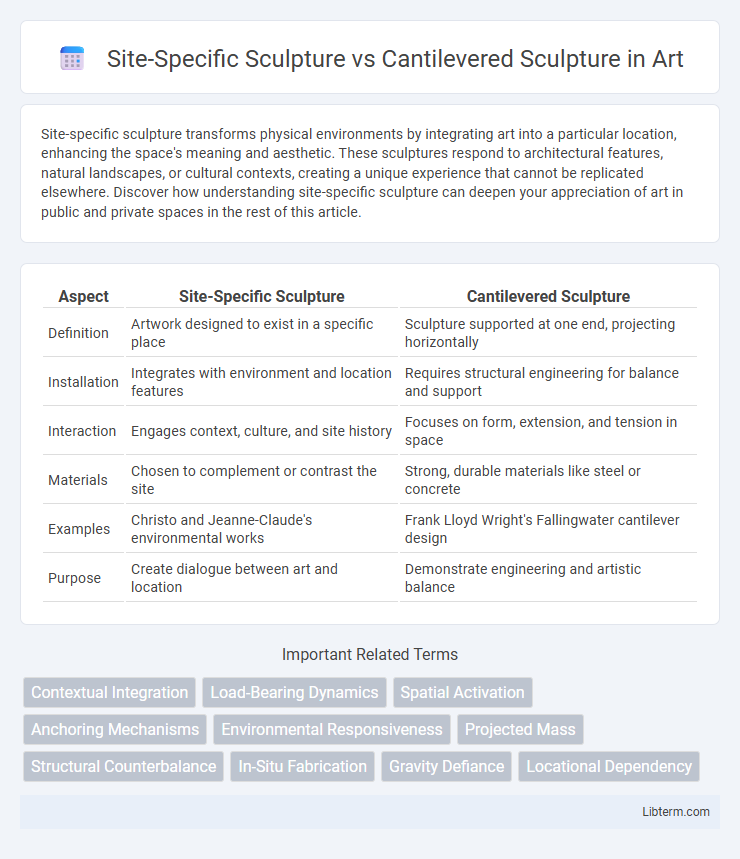Site-specific sculpture transforms physical environments by integrating art into a particular location, enhancing the space's meaning and aesthetic. These sculptures respond to architectural features, natural landscapes, or cultural contexts, creating a unique experience that cannot be replicated elsewhere. Discover how understanding site-specific sculpture can deepen your appreciation of art in public and private spaces in the rest of this article.
Table of Comparison
| Aspect | Site-Specific Sculpture | Cantilevered Sculpture |
|---|---|---|
| Definition | Artwork designed to exist in a specific place | Sculpture supported at one end, projecting horizontally |
| Installation | Integrates with environment and location features | Requires structural engineering for balance and support |
| Interaction | Engages context, culture, and site history | Focuses on form, extension, and tension in space |
| Materials | Chosen to complement or contrast the site | Strong, durable materials like steel or concrete |
| Examples | Christo and Jeanne-Claude's environmental works | Frank Lloyd Wright's Fallingwater cantilever design |
| Purpose | Create dialogue between art and location | Demonstrate engineering and artistic balance |
Introduction to Site-Specific and Cantilevered Sculptures
Site-specific sculpture is designed to interact harmoniously with its specific location, considering environmental factors such as space, natural elements, and cultural context to enhance the viewer's experience. Cantilevered sculpture features an extended structure supported at only one end, creating a dynamic sense of balance and tension that challenges traditional forms of stability. Both art forms emphasize spatial relationships, with site-specific works rooted in place and cantilevered sculptures exploring architectural and structural innovation.
Defining Site-Specific Sculpture
Site-specific sculpture is an art form created to exist in a particular location, integrating its physical, cultural, and environmental context to enhance meaning and viewer experience. Unlike cantilevered sculpture, which often emphasizes structural balance and extends horizontally without additional support, site-specific works cannot be relocated without losing their intended significance. These sculptures engage directly with their surroundings, making space and place essential components of their artistic identity.
Understanding Cantilevered Sculpture
Cantilevered sculpture features elements that project horizontally into space, supported only at one end, creating a sense of balance and tension that challenges gravity and structure. Unlike site-specific sculptures, which are designed to exist harmoniously within a particular environment, cantilevered sculptures emphasize structural innovation and visual drama through overhanging forms. Mastery of materials such as steel or reinforced concrete is essential to achieving the stability and aesthetic impact characteristic of cantilevered artworks.
Historical Context and Evolution
Site-specific sculpture emerged prominently in the 1960s as artists sought to create works intrinsically tied to their environment, challenging traditional gallery confines and emphasizing spatial and cultural context. Cantilevered sculpture, tracing its roots to early 20th-century engineering feats, evolved through modernist experimentation with balance and tension, notably advanced by artists like Alexander Calder. Both forms reflect shifting artistic paradigms: site-specific works prioritize integration with location and meaning, while cantilevered sculptures highlight innovation in form and structural dynamics.
Creative Intent: Artist’s Perspective
Site-specific sculpture is created with a deep understanding of its environment, reflecting the artist's intention to engage directly with the physical, cultural, and social context of the location, thereby enhancing the viewer's experience through a meaningful spatial relationship. Cantilevered sculpture emphasizes structural innovation and balance, showcasing the artist's exploration of form, tension, and gravity without reliance on external supports, often highlighting engineering prowess alongside aesthetic expression. Both approaches reveal distinct creative intents: site-specific works prioritize contextual dialogue, while cantilevered sculptures focus on the dynamic interplay between form and force.
Structural and Material Considerations
Site-specific sculptures demand materials and structures that harmonize with their surroundings, requiring durability against environmental conditions and an integration that complements the landscape or architecture. Cantilevered sculptures rely heavily on strategic weight distribution and tensile strength, often utilizing steel or reinforced concrete to achieve balance and stability without additional supports. Both types necessitate precise engineering, but cantilevered designs emphasize dynamic equilibrium, while site-specific works focus on contextual resilience and material adaptability.
Interaction with Surroundings
Site-specific sculptures are designed to harmonize with their environment, integrating natural elements, architecture, and cultural context to create a meaningful dialogue with the space. Cantilevered sculptures emphasize structural balance and engineering, projecting outward without external support, thereby interacting dynamically with gravity and spatial perception. Both forms engage viewers by altering their experience of the surroundings, but site-specific works embed meaning through context while cantilevered sculptures highlight tension and physical extension.
Audience Engagement and Experience
Site-specific sculptures transform environments by engaging audiences through contextually rich interactions, creating immersive experiences tied to the location's cultural or natural elements. Cantilevered sculptures captivate viewers with their dramatic balance and engineering, invoking awe and encouraging a physical sense of tension and movement in the observer. Audience engagement differs as site-specific works promote contemplative connection within a setting, while cantilevered forms emphasize dynamic perception and spatial awareness.
Notable Examples Worldwide
Site-specific sculptures like Richard Serra's "Tilted Arc" in New York and Christo and Jeanne-Claude's "The Gates" in Central Park emphasize integration with unique environmental contexts, creating a dialogue with their locations. Cantilevered sculptures, exemplified by Alexander Calder's "Flamingo" in Chicago and Anish Kapoor's "Marsyas" in Tate Modern, showcase balance and structural ingenuity, projecting dramatic forms into space without direct ground support. Both styles challenge traditional sculpture boundaries, with site-specific works rooted in place-specific experiences and cantilevered pieces highlighting architectural tension and spatial dynamics.
Conclusion: Comparing Impact and Significance
Site-specific sculptures transform their environments by integrating context, history, and spatial dynamics, creating immersive experiences that resonate uniquely with their locations. Cantilevered sculptures emphasize structural innovation and balance, often evoking tension and movement through their engineering feats and visual extensions into space. Both forms significantly influence public perception of art, but site-specific works anchor cultural narratives in place, while cantilevered sculptures challenge physical boundaries and encourage dynamic interaction.
Site-Specific Sculpture Infographic

 libterm.com
libterm.com